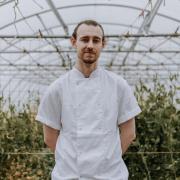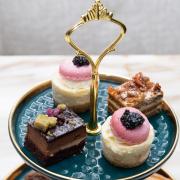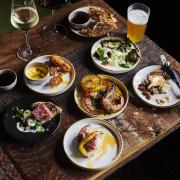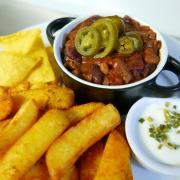Want to feel intrepid, thrifty, connected with nature and well-fed? Foraging’s the way forward! Anna Lambert spends an afternoon on the Kent coast with a wild food expert who also happens to be a gourmet cook
We were told to gather on the clifftop at Pegwell Bay, next to the replica Viking ship Hugin, for our foraging session with Deal-based Lucia Stuart and her Wild Kitchen team. With the ship a gift from Denmark in 1949, marking the AD 449 Ebbsfleet landing of Anglo Saxon chieftains Hengist and Horsa, was the location going to set the tone for a morning of invader-esque pillaging, albeit of plants rather than people? Far from it – one of the first foraging tips Lucia gave our group of 12 (a mix of locals and those who’d come down especially from London for the day) was, ‘Just take enough of the plant for your needs – no more, no less. Leave plenty for other creatures to enjoy and for the health of the plant itself.’

And if there’s one thing the foraging walk showed us in sunshine-dappled detail it’s that there’s an abundance of good things out there to be gathered – more than enough for everyone. Rosehips, sloes, and small, plump, deep-indigo-coloured damsons (‘one of my favourites and named after Damascus, from where they originally came’ says Lucia) lined the hedgerows as we walked past fields of oats, the sea glinting on our right. Some of us gathered the berries for later use, with plenty of advice from Lucia as to how use them in jelly, jams or infusions; others simply gathered knowledge. A particular revelation was the dock leaf – most of us know it best as a cure for nettle stings, but its seeds make a delicious, nutrient-packed addition to any sort of bread. And unripe blackberries, we discovered, take on a deliciously sweet juiciness when quickly pickled in vinegar and sugar. Heard of Alexanders? Probably not – but you’d most likely recognise their green, celery-like leaves. As Lucia explained, these are good in a salad and their peppercorn-style seeds will add a subtle spice to all sorts of dishes. We gleaned a wealth of tips, with Lucia always keen to emphasise the health benefits of the foods we came across.
On we went, feeling especially intrepid as we negotiated ourselves and one another down a steep bank. Lucia had handily tied a rope to nearby trees here for us to hang onto (though, thankfully, not for dear life: the bank was pretty small). From here it was through an old smuggler’s tunnel, which these days takes the unprepossessing form of a very large underground pipe. While the tunnel might have been a bit of an anticlimax, what greeted us as we emerged certainly wasn’t. Beautiful Pegwell Bay stretched in front of us, and it was the plants here, among the mudflats and pools of saltwater, that offered the biggest surprises. Turns out there’s edible vegetation everywhere, and ‘Seafood’ needn’t only mean fish and crustaceans. The nutrient-packed succulent (by name and by texture) sea purslane was surprisingly good; sea beet – introduced by the Romans when they came across the waters all those centuries was ago – tasted like a ready-seasoned spinach, while sea-blite, we learned, with its delicate flavour, is another succulent that works equally well eaten raw or cooked. Stars of the seaside show, though, in terms both of flavour and colour, were the tiny, bright-orange sea-buckthorne berries (‘absolutely not to be confused with black buckthorne berries, which are poisonous’ points out Lucia). We found them growing en masse in bushes on what had once been the car park for the long-abandoned hovercraft terminal further up the beach. ‘They have a sharp flavour that brightens any food and they’re packed with vitamin C’ explains Lucia. ‘I think of them as our equivalent of citrus’. With sharp thorns to be avoided, we picked these very carefully (Lucia had gloves we could borrow) and learned that the berries are easiest to remove safely once the branches have been frozen.


All this outdoor activity and talk of food – not to mention the sea air – of course made us hungry, which is where Lucia is able to offer something truly special. Together with a couple of friends from her art school days, for over ten years she ran Cafe du Livre in Montolieu, a town known as France’s Hay on Wye due to the number of bookshops it contains (and a particularly appropriate base for Lucia, given that her step-father, bookseller Richard Booth, was known of the, ‘King of Books’ in the England-Wales border town). There, she was inspired by a regular customer, a botanist and war veteran called Julien, or “Juju”to his friends. ‘Every morning Juju came to the cafe with his arms full of plants for us to experiment with,’ she explains, ‘and that was the start of my fascination for all things foraged’.
Lucia returned to the UK in 2012, having inherited her father’s lovely Georgian terraced home in Deal, and now offers all sorts of dining and foraging experiences across the country, and sometimes abroad, but with her heart very much in Kent. ‘It’s the sheer range of what we have here because of the variety of the landscape that’s so special,’ she says ‘Everything from woodland nuts and berries to the sort of sea plants we’ve been able to make the most of today.’

Lucia’s gourmet skills were given full reign when we weaved our way to a clump of grasses above the sands. Here, under an awning that swayed gently in the wind, Lucia’s team had laid out a decidedly upmarket foraged-picnic lunch, with chairs, tin plates, gingham napkins, proper cutlery and glasses – stylish and all very civilised. Aperativos of sea-buckhorn berry gin and lavender lemonade and nibbles of marrow topped with bean were passed around, followed by tiny beakers of chilled wild fennel and cucumber lassi. More substantial delights arrived: lime-leaf polenta puffs with nasturtium mayonnaise, sea-blite mozzarella cakes, Kentish cheese served with acorn and seaweed crackers alongside rowan jelly, rounded off with a berry tart and wonderful green-walnut ice-cream.
Our session with Lucia had revealed the natural bounty on our doorstep and what she could do with it. But arguably the proof of the foraging pudding lies in whether or not I’d be inspired to follow her example. I can report that, back in my own Kent kitchen, I used my bounty to create a sea-blite and purslane pesto (whizzed up with garlic, Kent cobnuts and rapeseed oil), which proved delicious stirred through linguine. I also cooked my sea-buckthorn berries over a low heat, sieved them, then mixed them with sugar to taste. Combined with a chilled splash of one of Kent’s great sparkling wines, Sea-Buckthorne Fizz could well become my new tipple of choice. Cheers!
Wild Food gourmet events with Lucia cost from £126. thewildkitchen.net

Three scrumptious recipes from Lucia to try for your own foraged feast
Bramble coconut-cream tarts
Ingredients: Cream, blackberries, sugar, desiccated coconut, egg white
1. Forage: Juicy ripe blackberries.
2. Mix: half a cup of white sugar, 2 cups desiccated coconut and 2 egg whites that have been lightly whipped together in a bowl
3. Press the mixture lightly into well buttered (or else it will stick) tartlet trays or moulds for baking.
4. Bake the tart bases in the oven at 170C for 10 to 15 minutes or until the coconut turns pale gold. Leave to cool in the tin.
5. Crush the foraged blackberries tossing in a little honey or sugar. Save some berries for garnishing.
6. Whip 200 ml double cream and fold it into the blackberry mixture.
7. To serve : Arrange the tart bases on a large plate and add dollops of the blackberry mixture decorated with one magnificent and shiny blackberry on top.
Rose hip power powder
![Great British Life: Rosehip powder [illustration Lucia Stuart] Great British Life: Rosehip powder [illustration Lucia Stuart]](/resources/images/17267883.jpg?type=mds-article-575)
Ingredients: Rose hips
1. Forage: Rosa Rugosa hips, as they can be as big as small apples.This is the Japanese rose with deep pink magenta coloured petals that grows wild near the sea and golf courses of Kent. Twist and pull the stem of the soft, ripe red hips. Avoid the sharp thorns on the stems.
2. Cut the hips in half and, using a small teaspoon, scrape out just the seeds from inside (save these and mix with almond or olive oil to be used as a beauty scrub).
3. Dry pieces of the soft skin and flesh of the hips in a low heat in the oven (100 degrees) or a de-hydrator. Check regularly to see when they are hard and dry.
4. Powder the hip flesh in an electric blender ideally one used for coffee or spices. The hips need to be 100% moisture-free to powdered.
5. Store : The powder sits nicely in a small bottle and will last for many weeks. Sprinkle over any food you like to eat as a magic dust that's full of vitamins …
Seaweed butter
![Great British Life: Seaweed butter [illustration Lucia Stuart] Great British Life: Seaweed butter [illustration Lucia Stuart]](/resources/images/17267884.jpg?type=mds-article-575)
Delicious on grilled fish
Ingredients: Unsalted butter, salt, seaweed
1. Forage: Pluck a handful of bright green seaweed -sea grass or sea lettuce - gently from the rocks.
2. Prepare: Rinse it in clean water to remove sand.
3. Whizz up 150 grams of warm, unsalted butter in a strong electric blender with the seaweed (or use a mortar and pestle), until smooth and creamy adding salt to taste if necessary.
4. Spoon the butter into a dish to cool in the fridge, or store in the freezer for long-term preservation.
5. To serve with fish: melt a couple of spoons of seaweed butter in a small pan on a low heat adding a little salt, lemon juice or a splash of white wine if needs be. Pour over cooked fish.
Essential foraging advice
• Safety is paramount: ‘There’s an old saying,’ says Lucia. ‘There are bold foragers and there are old foragers, but there are no bold, old foragers. If you’re not absolutely sure what you’re picking, do not eat it.’
• Only collect from plentiful populations
• Know the law – as the Woodland Trust points out: ‘All wild plants are protected under the Wildlife and Countryside Act (1981). It is illegal to dig up or remove a plant (including algae, lichens and fungi) from the land on which it is growing without permission from the landowner or occupier. Some species are specially protected against picking, uprooting, damage and sale. A list of these can be found on Schedule 8 of the Wildlife and Countryside Act (1981).’
For more information, see woodlandtrust.org.uk
MORE KENT FORAGERS
Jack Raven Bushcraft offers day-long foraging courses along the North Downs Way; with participants (a maximum of eight in any group) collecting common plants, hedgerow fruits, berries and nuts along the way. Over a camp fire in local woodland, you’ll then prepare and cook what you’ve found, to create a selection of edible treats. From £95 jackravenbushcraft.co.uk
Self-sufficiency and wild food expert Michael White, based in Cranbrook, shares his lifetime of foraging experience in an engaging and informative manner and says he’s just as happy to cater for foraging beginners as expert wild food aficionados. Courses include the gathering, cooking and sampling of wild food, and a light lunch. From £45 for a half day. Ruralcourses.co.uk.
Badger bushcraft
At venues including Maidstone’s Mote Park, participants can join forager and wild food expert Carol Hunt and bushcraft and survival skills instructor, Phil Brown, for a family session with the chance to cook lunch. £49. badgerbushcraft.com
Forth and Forage
Based in Herne Bay, Amy Hitchcock specialises in a whole range of family-friendly excursions from a Bramble Ramble to an Elderflower Berry Woodland Walk. Discover fruit, herbs and even spices. From £20, with free places for children. forthandforage.co.uk.
Natural Pathways
Hannah Nicholls has been leading foraging and bushcraft expeditions around Canterbury for nigh on 20 years. Her ‘Foraging and fire’ sessions will have you finding edible plants, berries, barks, seeds, roots, to be processed and cooked over fire back at camp – Lucia Stuart sometimes helps too. £90 natural-pathways.co.uk




























